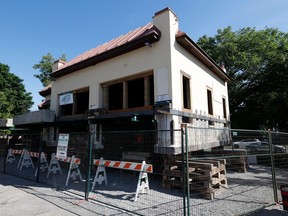Westboro residents turned out to see the Champlain Oil “cottage” gas station move from its home at the corner of Island Park Drive and Richmond Road

Article content
In the dead of a warm June night, a 90-year-old heritage gas station found a new, temporary home.
Around 12:30 a.m. on Monday morning, Westboro residents turned out to see the Champlain Oil “cottage” gas station move from its home at the corner of Island Park Drive and Richmond Road, where it has sat for nearly a century.
For now, the yellow cottage will sit down the street at 77 Richmond Rd., while a nine-storey, 103-unit residential development is built in its place. Once that project is near completion, the heritage building will be moved yet again, incorporated into the new development in a prominent spot, near the sidewalk of Richmond Road.
Advertisement 2
Story continues below
Article content
Built in 1934, the yellow structure is “essentially a cinder-block building,” Kitchissipi ward Coun. Jeff Leiper said Monday. “A lot of us were surprised you could move it whole, over that distance, in one piece, without it falling apart.”
The Tudor Revival-style building resembles something of an old English cottage, similar to some nearby homes on Island Park Drive. It operated as a gas station until the 1980s, when it became a used car lot. Only a few such “cottage” gas stations still exist in North America today.
Leiper said the gas station is a particularly interesting piece of his ward’s history. When the gas station was first built, it was considered far flung from Ottawa’s city centre, and a place for motorists to stop and fuel up. Now, he said, it serves as a symbol of how the automobile impacted Ottawa’s growth patterns over the past several decades.
Leiper says the gas station was designated as a heritage structure because it represents how the city was transformed by the automobile, he said. “It reflects changing travel patterns for people.”
Now, with its integration into the new residential development, the cottage is again a symbol of how the city is growing — now with an emphasis on density.
Advertisement 3
Story continues below
Article content
The city’s most recent official plan “really doubles down on intensification,” Leiper says. “It’s one of our key responses to sprawl, environmental challenges, and is an economically sustainable way to grow.”
People in his ward have “mixed feelings” about the tall buildings popping up, he said, but “it’s the reality of how the city has to develop if it’s going to develop sustainably.”
But, he added, “it doesn’t necessarily mean we have to lose our heritage.”
Kitchisippi, he said, is “underrepresented” when it comes to buildings that have heritage designation and protection, but it’s important to make sure the touchstones of the neighbourhood’s identity are preserved.
“The fact that (the developer) has been able to incorporate this building, with the type of development that needs to take place in a sustainable city, is really encouraging.”
Ahmed Zayed, vice-president of Trinity Group, the developer of the project, said the decision to preserve the heritage building was a collaborative one with the city and local residents.
“We came up with a plan to preserve all of it, not just one wall or facade,” he said. “We’re preserving it, moving it off-site and then bringing it back.”
Advertisement 4
Story continues below
Article content
That’s no small task. Zayed said it took a while to find a temporary location to “park” the building, and hydro wires needed to be buried underground to accommodate the equipment. Roads were closed for the duration, which is why it happened in the middle of the night.
Once the building is complete — about two years from now, Zayed estimates — the developer will be looking for a tenant for the heritage building, with the hopes that a restaurant could operate with a patio and gathering space for the community.
Coun. Rawlson King, chair of the city’s built heritage committee, said the project is an example of “adaptive reuse,” where a heritage building is renovated to suit modern purposes.
“There’s no reason why we can’t see the successful preservation and renovation of a historic structure that also contribute to urban regeneration,” he said. “It opens up new life for the buildings.”
With files from Postmedia
Recommended from Editorial
Article content


Comments